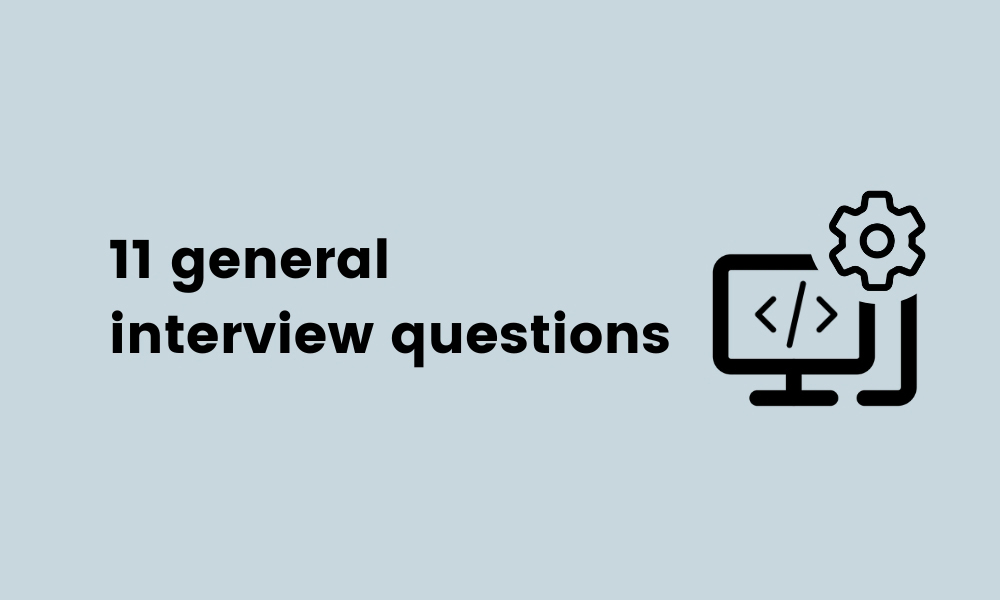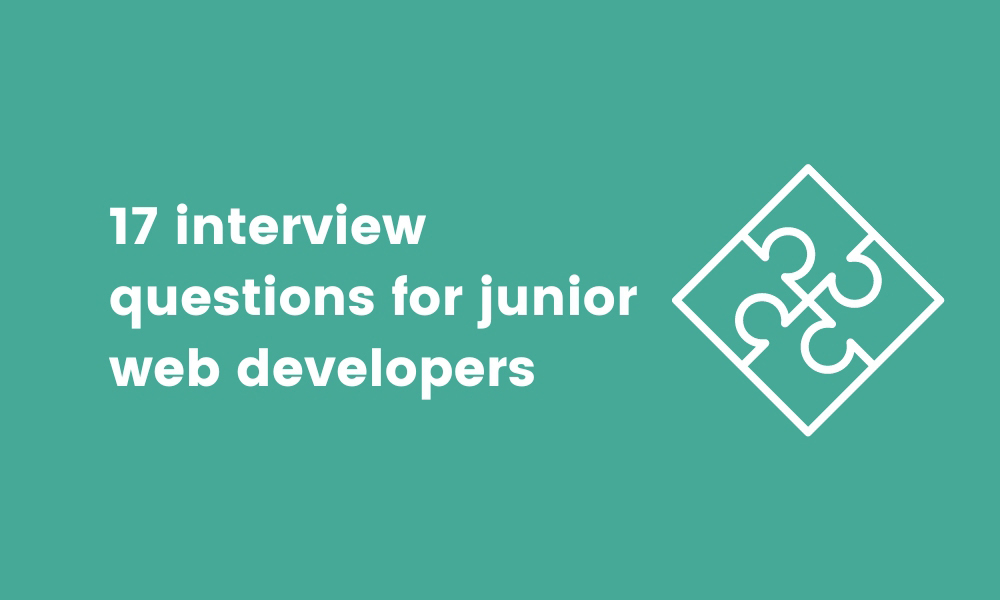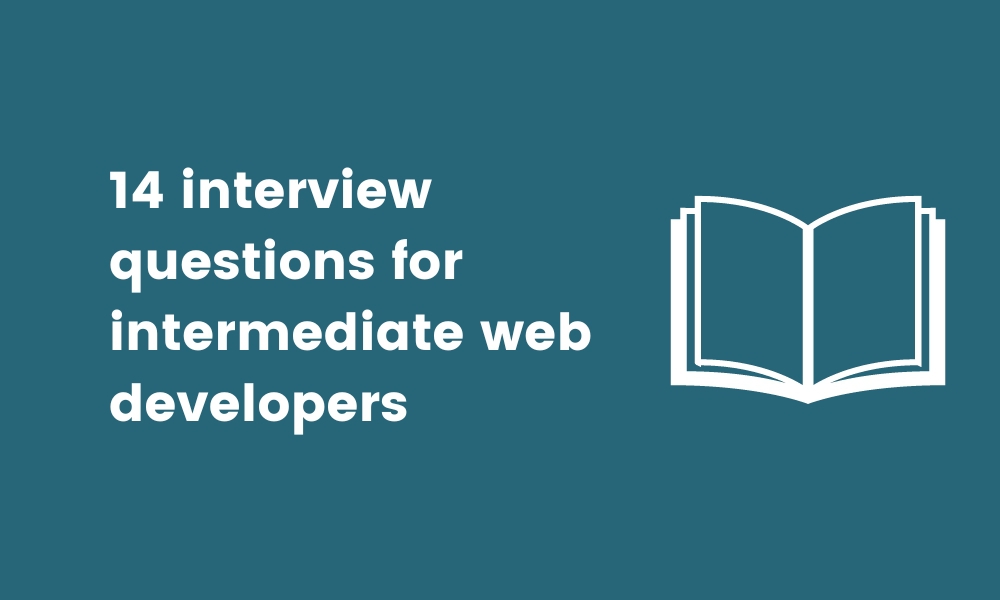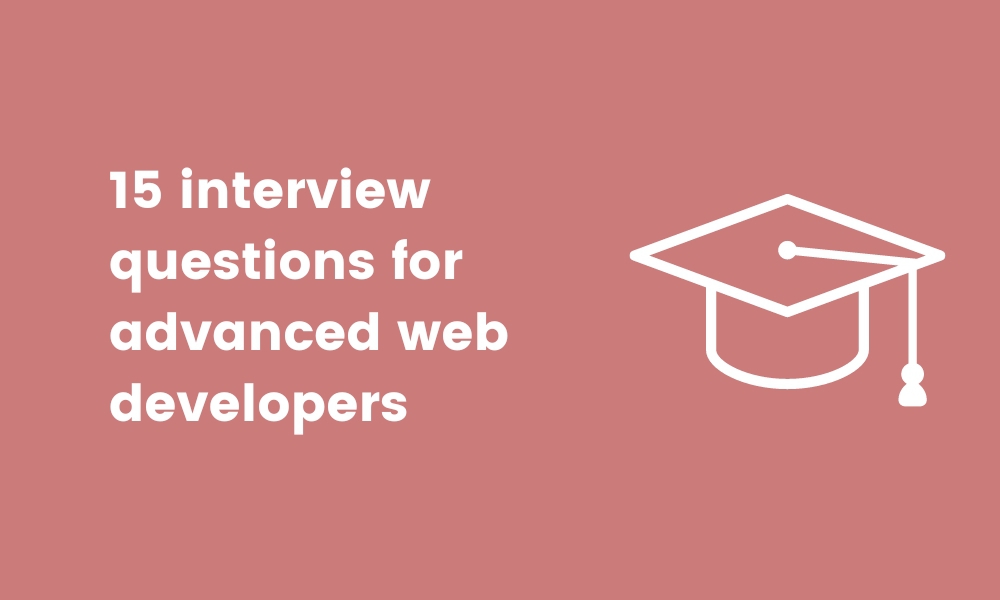57 web-developer interview questions to hire an expert
Whether you’re a human resources manager, recruiter, or hiring manager, you’ll know that hiring web developers can make or break an organization. Hiring the right people will give you an edge over the competition.
Finding the right candidates with expert knowledge of Python algorithms, React, or Gatsby.js has never been more important.
How do you do that, though?
Structured interviews in which you ask your candidates the right web-development questions can really help you assess their skills in depth.
Additionally, with an online skills assessment platform like TestGorilla, you can measure applicants’ ability and knowledge even before interviewing them, saving you both time and money by filtering out unsuitable candidates early on in the hiring process.
Candidates who perform well on skills tests such as our Gatsby.js or React tests have a much better chance of success in the role of a web developer – and if you complete the skills assessment with an interview, you’ll have a full understanding of their capabilities.
To help you prepare for your next web-developer interview, we’ve compiled a list of 57 web developer interview questions.
11 general interview questions for web developers
In this section, you’ll find 11 general interview questions for web developers to help you start the interview. Use the sample answers to evaluate your applicants’ responses.
1. In your last role, what were your responsibilities as a web developer?
The purpose of this question is to assess the candidate’s knowledge of the role and their experience. Look out for candidates with experience in similar positions, an understanding of the duties of web developers, and the capacity and willingness to take on new responsibilities.
2. Can you tell me about your experience with different programming languages?
This question assesses the candidate’s familiarity with different programming languages and determines whether further training is needed.
Keep an eye out for candidates with coding experience in the same languages as the ones your organization uses – they’ll be able to get up to speed faster and not need as much training to become productive.
3. What motivated you to become a web developer?
This question assesses whether candidates are passionate about their work and helps you evaluate their motivation for applying at your company. Look for passion and enthusiasm for web development, a good understanding of the position’s requirements, and enough experience in a similar role.
4. Can you recall a time when a client was unhappy with your work? How did you handle this?
The purpose of this question is to assess the candidate’s customer-service and conflict-resolution skills. Look for evidence of applicants’ ability to communicate well with others, to maintain high levels of customer satisfaction, and to resolve conflicts successfully.
5. Can you tell me about the skills that make you a good web developer?
Ask this question to determine whether the candidate’s skills match your requirements. Look for a sense of confidence in their abilities and skills.
6. What has been your most challenging project in web development?
This question assesses the candidate’s level of experience and their ability to adapt to change, deal with unforeseen circumstances, and solve problems. Look for candidates who can work well under pressure, resolve conflicts, and overcome roadblocks to complete projects successfully.
7. In your previous role, did you have direct contact with clients?
This question aims to determine whether the candidate would be a good fit for your team if the role calls for client communication and management. Look for candidates with excellent communication and interpersonal skills, client-facing experience, and adaptability to various environments.
8. How would you describe your ideal working environment?
The purpose of this question is to determine if a candidate would be a good fit for your company. Look for candidates with work experience in various environments who can easily adapt to new teams and methods of work.
9. What do you do to stay on top of industry news and trends?
This question determines whether candidates are passionate about web development and keep themselves up-to-date with the latest industry trends. Look for applicants with working knowledge of current trends and developments in the industry, as well as those who are enthusiastic about web development as a whole.
10. What is the best way to explain the web-development process to clients unfamiliar with the field?
This question assesses a candidate’s ability to explain industry terms to non-technical clients.
Look for applicants who show an ability to communicate effectively with others, especially those with non-technical backgrounds, and can translate industry-specific knowledge into simpler terms to adapt it to various audiences.
11. What steps do you take to ensure your work is error-free?
This question assesses a candidate’s web-development process, and especially whether they double-check their work. Look for candidates who can show evidence of successfully catching mistakes in the past and who have an established process for detecting and eliminating errors.
17 basic interview questions for junior web developers
In this section, you’ll find 17 interview questions you can ask junior applicants. Use them to evaluate whether your candidates have the basic skills they need for the role.
1. How do SOAP and REST differ?
SOAP (short for Simple Object Access Protocol) is a web development protocol that works with XML. REST (short for Representational State Transfer) is an architectural platform that also works with XML but can additionally work with HTML and plain text.
An important note is that REST can use SOAP, but SOAP cannot use REST.
2. In web development, what is the purpose of a namespace?
Namespaces are simple global objects that hold properties, methods, and other objects inside them. Namespaces use modularity so users can resume code without naming conflicts.
3. In HTML5, what new input types are available?
HTML has undergone multiple revamps in recent years, making it easy to work with. New input types for HTML5 include:
Email
URL
Datetime-local
Month
Color
Number range
4. HTML5 has five elements to support media content. What are they?
The five main elements that support media content in HTML5 are:
5. Can you tell me what SVG is and why it is used?
The term SVG refers to Scalable Vector Graphics. You can use SVG to display vector-based graphics online. It renders graphical content based on an XML format. By using SVG, the user can create high-quality images with superior graphical content.
6. In HTML, what is the purpose of Canvas?
Adding Canvas to HTML5 allows users to draw graphics on the go using JavaScript. You can draw boxes, paths, circles, images, and more on utilizing various methods.
7. How do Canvas and SVG differ?
Canvas is dependent on resolution and does not support event handlers. For rendering applications on a small scale, Canvas works well.
SVG is not dependent on resolution and supports event handlers. For large-scale rendering applications, SVG is the optimal choice.
8. What can you do to reduce page loading time?
A website’s page loading time is affected by a number of factors. It can, however, be vastly reduced by implementing some methods, such as:
Image-size reduction
Minimizing caching and redirection
HTTP compression
Lookups reduction
Removal of unnecessary widgets
9. What is CORS?
CORS, short for Cross-origin Resource Sharing, is a mechanism allowing multiple resources to be requested simultaneously from a domain outside the current request domain.
10. How are localStorage and sessionStorage objects different?
With localStorage, there is no expiry for stored data, and it does not delete data when you close the window. With sessionStorage, an object is only valid for a single session, and it’s deleted immediately when you close the window.
11. Can you tell me about some of the new features that CSS3 brings?
Many changes have been made to CSS3 to make it more powerful and user-friendly. Some of those features are:
Animation
Custom layout
Media queries
Rounded corners
12. How does Responsive Web Design (RWD) work in HTML and CSS?
With responsive web design, web pages can be scaled across multiple resolutions with minimal screen tears. A web page’s structure automatically adapts to the device it is viewed on to provide the best viewing experience.
13. Among the CSS types, what are some of the most popular?
CSS comes in three main types:
Inline CSS, which allows CSS to be added inline alongside HTML elements
External CSS, which imports an external CSS file into an HTML document
Embedded CSS, which adds CSS styles via the attribute
14. In CSS, what is the purpose of a selector?
With CSS selectors, HTML elements can be easily found and selected based on name, ID, attribute, and more.
15. In CSS3, what is the purpose of grouping?
Grouping allows users to reuse and apply the same CSS style element to several HTML entities with one declaration statement.
16. In CSS, what is the purpose of a class selector?
A class selector selects a statement and changes its style in the related part of the HTML tag.
In CSS, class selectors begin with a “.” key, followed by the class name.
17. In CSS3, what is the purpose of Webkit?
CSS includes a software component called Webkit, which allows HTML and CSS elements to be rendered in a variety of browsers, including Firefox, Safari, and Chrome.
There are multiple engines for browsers, for example:
Edge for Internet Explorer
Gecko for Mozilla
Presto for Opera
The best insights on HR and recruitment, delivered to your inbox.
Biweekly updates. No spam. Unsubscribe any time.
14 intermediate web-developer interview questions
Below, you’ll find 14 web-developer interview questions for candidates who already have some experience but aren’t yet senior developers. Use our sample answers to assess their knowledge and expertise.
1. In what ways does CSS3 facilitate the implementation of rounded borders?
With CSS3, elements can be created with attractive-looking rounded corners using the property. You can apply this to all four sides or according to your needs.
has four attributes:
2. What is pagination and how does it work?
A website’s pagination is a simple sequence of pages. Users can view similar content on these pages because they are interconnected.
For example, an e-commerce website could feature a page selector that allows users to browse several pages simultaneously rather than scroll up and down the same page.
3. The CSS box model is composed of what components?
A CSS box model represents an entity that retains all HTML content in a box or a button element.
There are four components:
Content: The actual content displayed
Border: The padding and content around the border
Padding: The empty space around an element
Margin: The top layer of the box element
4. In CSS3, what are some of the properties of transitions?
Users can quickly and efficiently create animation effects with CSS3 transitions.
There are four main properties of transitions:
transition-delay
transition-timing-function
transition-property
transition-duration
5. In CSS, what is the purpose of pseudo-classes?
In CSS, pseudo-classes are used to change the style of an element when its state changes.
Pseudo-classes can be used in a variety of ways, such as:
Out-of-focus animations
The style change when the mouse hovers over the element
Providing styles for external links
6. In CSS3, what is the purpose of media queries?
In CSS, media queries define styles that are responsive to various viewing window sizes and shapes.
The following entities can be adjusted:
Viewport
Height
Width
Orientation
Resolution
7. What is the purpose of float in CSS?
In CSS, float controls an element’s position and layout on a web page. Depending on the requirements, you can place any element on the web page.
8. In CSS, what is the z-index?
In CSS, the z-index determines the order of elements on a page. The hierarchy is based on order indices, where a higher-order element appears before a lower-order element.
It applies only to positioned elements, i.e., those elements with the compulsory position attribute.
9. What are the advantages of external style sheets?
There are several advantages to using external style sheets, such as:
There’s no limit to the number of times a class can be reused
Styles can be applied easily using selectors and grouping
One file can control the style of multiple documents
10. In web development, what does long polling mean?
Long polling is a pattern developers use to mimic a data-push operation from a server to a client machine.
Data is pushed from the server to the client during long polling. Connection timeout will only occur if the timeout criteria are met or the data has been sent to the client.
11. What are some of the web development technologies that you know?
An experienced web developer will have sound knowledge of the following technologies:
JavaScript
HTML
PHP
CSS
SQL
Python
Look for candidates who can give you specific examples of their experience with each of these technologies.
12. How do cookies and local storage differ?
With cookies, both the client and the server have access to cookie data, and data is deleted after the expiry date. With local storage, client-side machines store data locally in their browsers, and data never expires (unless deleted manually).
13. How are XHTML and HTML different?
With XHTML, tags need to be in lowercase and closed once opened. Also, you need to enclose attributes using double quotes. With HTML, tags are not case-sensitive and can be open-ended. Additionally, you can use attributes without quotation marks.
14. In JavaScript, what types of data are there?
JavaScript supports the following data types:
Boolean
Function
Number
Null
Object
String
Undefined
15 advanced interview questions for senior web developers
Here, you’ll find 15 advanced web-developer interview questions to assess senior applicants who have more than 3-5 years of experience in the role. We’ve also included sample answers to help you evaluate their responses.
1. In JavaScript, what types of popup boxes are available?
JavaScript has three types of dialog boxes:
Alert, which displays a message with an ‘OK’ button
Confirm, which displays a window with ‘OK’ and ‘Cancel’ buttons
Prompt, which displays user input alongside ‘OK’ and ‘Cancel’ buttons
2. In what way are window.onload and onDocumentReady different?
The <window.onload> event isn’t called until the whole page has loaded with all of its CSS styling and images. There is a slight delay when rendering a web page as a result.
With the event, the event action will begin only after the DOM is initialized. As a result, any delays in actions are reduced.
3. In JavaScript, how are type conversions handled?
JavaScript supports automatic type conversion. You can easily pass a function into another function as it is weakly typed.
As values are automatically converted to the required data type, there are no errors or warnings.
4. In JavaScript, what does the scope of a variable mean?
Scope describes how accessible functions and variables are in the running environment. JavaScript supports two scopes:
Local scope: Values and functions declared within the same function can only be accessed within that function
Global scope: When a variable is declared global, it is accessible everywhere in the application
5. What is the purpose of JavaScript comments?
Two types of comment insertion are supported by JavaScript in the code:
Single-line comment: “//” inserts single-line comments
Multi-line comment: “/* */” adds multi-line comments
6. In JavaScript, why is the keyword so frequently used?
You use keyword to access the current object present in a program. This object lives inside a method. The keyword is used for referencing the corresponding variable or the object.
7. How does JavaScript’s attribute work?
The attribute is a boolean attribute that delays JavaScript code execution until the page has been loaded and initialized by the parser.
8. In JavaScript, what are undefined and undeclared variables?
Undefined variables are variables that have already been declared but not initialized.
Conversely, undeclared variables are variables that have not been declared and are being used in a program.
9. In a web application, how do you prioritize maintainability, performance, SEO, and security?
Different organizations will assign different levels of importance to each of these factors and figuring out the right balance between them is a crucial skill for successful web developers.
For example, companies that have large databases of customer information might prioritize security over SEO, while newly founded startups might prioritize SEO and performance to attract their first customers.
With this question, you’re trying to assess your candidates’ understanding of your company’s goals and whether they’ve done some groundwork before the interview.
10. If a jQuery event handler returns false, what happens?
If a boolean false value is returned by the jQuery event handler, the event will not continue to execute. The action that it’s associated with will be halted.
11. In jQuery, what does each() function do?
jQuery uses each() function to iterate over a set of elements. It is possible to pass a function to each() method. As a result, each event for which the object has been called will be executed.
12. Do you know what pair programming is?
During pair programming, you will work closely with a colleague to solve problems together. This is a great question to see if your candidates are used to working with others in close proximity.
13. In jQuery, what is the purpose of the $() function?
In jQuery, the $() function wraps objects into their jQuery counterparts. This way, users can call any method defined for the jQuery object.
You can also pass selectors to the $() function. As a result, a jQuery object containing matched DOM elements is output.
14. When using jQuery, what are the benefits of using a Content Delivery Network (CDN)?
The benefits of using a CDN are:
Significantly reduced server load
Substantial bandwidth savings
Faster loading times due to optimizations in jQuery frameworks
Faster loading times due to CDN caching
15. In jQuery, what types of CDNs are supported?
In jQuery, two CDNs are supported:
Microsoft: Loads from jQuery AJAX CDN
Google: Loads jQuery from the Google Libraries API
Recruit the best web developers by asking the right questions
Web design has a huge impact on the company’s credibility. That’s why you must attract the best web developers who have the right skills and knowledge to help your organization achieve its goals – and who fully understand web developers’ responsibilities and duties.
Asking the right web-development interview questions can help you identify the best candidates. We’ve provided a complete list above to help you prepare for interviews with your candidates. Check out our HTML interview questions if you’re looking to assess candidates’ proficiency with HTML. However, before conducting interviews, we recommend using an online skills-testing platform. This way, you’ll make your hiring process more objective and fair by assessing your candidates’ expertise rather than evaluating their résumés.
Skills testing also helps you save time and money by enabling you to concentrate only on your best applicants and quickly disqualify those who simply don’t have the right skills for the role.
For the best results, use specific language-based tests for the languages that your organization is using, such as our Gatsby.js test or our HTML5 test to hire a Gatsby developer or an HTML expert, respectively.
Next, combine these “hard-skills” tests with soft-skills testing. Remember, a candidate’s ability to solve problems and be self-motivated can often be more important than their technical skills, which could be picked up on the job. Here, you can use our Problem-solving and Motivation tests, to name a few.
Hire talented web developers quickly with TestGorilla as your online skills-assessment partner. Register for free today
You've scrolled this far
Why not try TestGorilla for free, and see what happens when you put skills first.


















